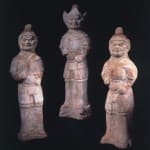Set of Three Tang Polychrome Guardian Figures, 618 CE - 907 CE
Terracotta
4.5 x 15.75
H.009
These unglazed figures were covered with white slip and then painted with mineral pigments. Over time, the original bright reds, greens and black faded though traces remain throughout on the...
These unglazed figures were covered with white slip and then painted with mineral pigments. Over time, the original bright reds, greens and black faded though traces remain throughout on the pointed caps, clad armor, layers of robe, and flowing pantalones. In this set, each figure bestows distinguishable characteristics, unique among burial objects that were mass produced. The central figure wears a distinctive cap with three triangular sections pointed upward covering the center top knot. The two side figures sport similar red caps that are bordered with a white flap, tight-fitting and expose the top knot. They differ in posture--one figure assimilates holding a weapon with the right hand lowered and the other vice versa. Though they resemble Deva Kings, they are most likely supernatural representations of fearsome military officers. Without uncertainty, their role was to protect the underground tomb and its inhabitant, and as retainer, to serve their sovereign in the realm of other-worldly existence. Considered to be the finest examples of Chinese burial objects, Tang figurines reached their peak in the first half of the eighth century The important role assigned to these models in Tang tomb arrangements and their significance as status symbols and powerful guardians protecting the dead meant that these clay figures became luxury objects. They reflect the artistic vitality of the time and give a unique perspective into Tang customs and practices as well as the contemporary upper class life.



